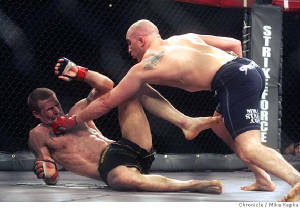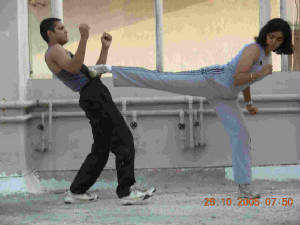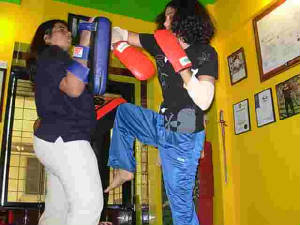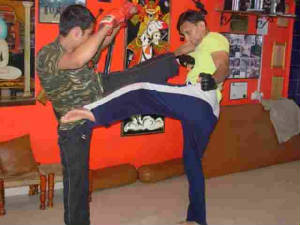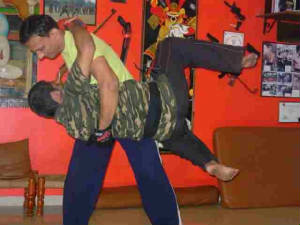

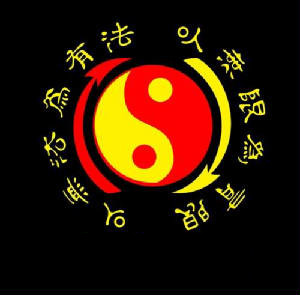
Mixed Martial Arts
Mixed martial arts (MMA) is a sport in which a wide variety of full contact fighting techniques are used, including strikes & grappling holds
Modern MMA tournaments as a popular phenomenon emerged in 1993 with the Ultimate Fighting Championship got the concept of pitting different fighting styles against each other in competition with few rules in place, in an attempt to determine which system would be more effective in a real situation.
The history of the modern MMA event can be traced to the Gracie family martial arts tournaments in Brazil in the 1920s.
The fighting concept of combining various combat disciplines gained popularity in the late 1960s and early 1970s with the emergence of Bruce Lees JKD and his theories of mixing various martial art styles.
The Martial Arts have evolved significantly over the last 100 years. More so than in any other time in the history of man kind. Partly, because as technology advances and the world becomes smaller, different forms of the martial arts have been tested and shared throughout the world. And, as evolution dictates, only the strong survive. So in the martial arts, Brazilian Jiu-Jitsu, Submission Wrestling, Muay Thai Kickboxing and Boxing have survived and remain dominant.
Mixed Martial Arts program trains you to be a "complete" martial artist. It is important to be well versed in various martial arts. There is not one style that teaches you everything you need to know. We utilize Brazilian (Gracie) Jiu-jitsu, Submission Grappling, Muay Thai Kickboxing, Boxing, and more! Students learn simple but effective counters to the most common self-defense situations such as bear hugs, head locks, choke holds, tackles, grabs and more! Mixed Martial Arts is on the cutting edge of fitness and the modern day martial arts that we teach are always as exciting as they are practical.
It is often wondered, why there should be different styles of fighting. There will always be different martial arts styles, but why should there be rules applied to “contact fighting"?
Lee has said "As long as an individual has two hand and two legs, he will fight in the same way" Then why do we have Karate Kumite, taekwondo sparring, Judo randori, and wrestling and boxing bouts?
I think fighting is divided only for convenience into different ranges. Long distance kicking range, medium distance hand range, intermediate knee & elbow range, close grappling and groundwork ranges.
Different ethnic groups have developed their own versions of each range, like kicking developed from China would be termed Shaolin Gung Fu, from Japan as Karate, from Korea as Taekwondo, from France as Savate, etc.
Similarly hand attacks are developed in western boxing, eastern karate, and Filipino Kali.
Knee elbow attacks are predominantly practiced in Filipino Kali, and in Muoy Thai from Thailand.
Westerners grapple and do groundwork with Wrestling and easterners with Judo and Dumog.
So we can conclude that martial arts are divided depending on predominant range and ethnic method of using that range.
But how can free style contact fighting develop without the combination of all ranges and styles?
But how can free style contact fighting develop without the combination of all ranges and styles?
Practitioners learn one style and get stuck to its limitations and start believing in it as the only truth. Then they say that they respect other styles. You can only respect a style when you derive from it. When you adopt its advantages and discard its limitations, yes for this you have to first open your mind to learning it. That means starting off as a beginner with the novices after already being an expert in your own style (which can at times seem demoralizing).
Lee advocated studying all ranges and imbibing the useful and reject the limitations. So the difficult to execute high kicks of taekwondo may be replaced by the groin and knee kicks, the high guard of boxig be rejected as it does not protect below the belt, while the rabbit and kidney fouls be absorbed. In grappling the fouls of head, neck locks and hammerlocks be absorbed, while the jacket throws be rejected.
Even on the mat the impact blows of karate be used along with the matwork principles of pinning of judo, along with the locking techniques of Filipino dumog and western wrestling.
Lee outlined these principles in his Jeet Kune Do and firmly stated that JKD is not a new system. But there are spates of JKD style schools all over the world. The immature martial artists search for a new style will never end.
All full contact martial artists must therefore advocate fighting in all ranges as part of their teaching curriculum.
